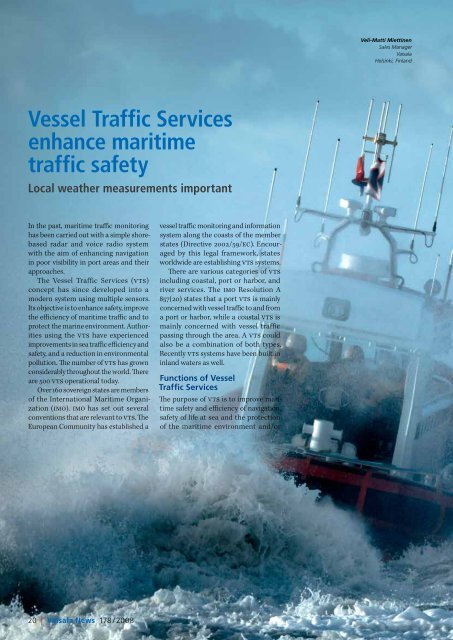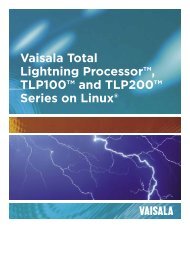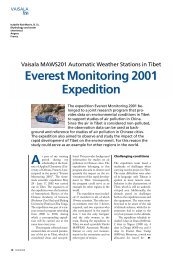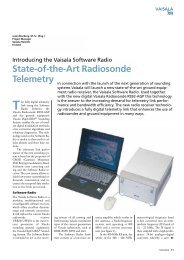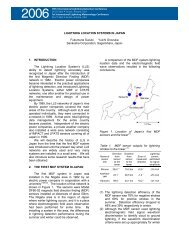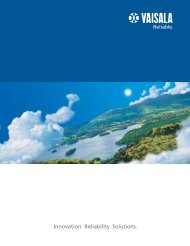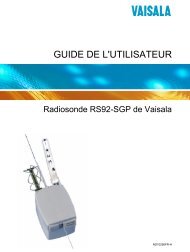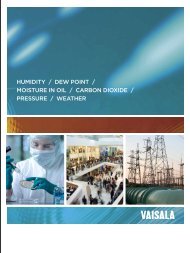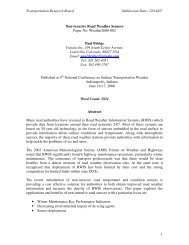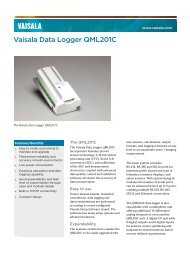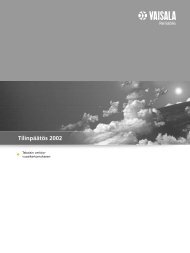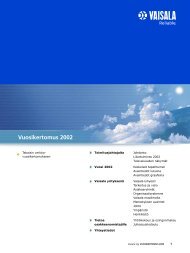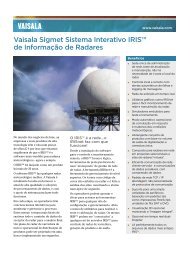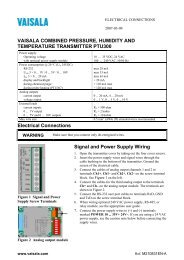Vessel Traffic Services enhance maritime traffic safety - Vaisala
Vessel Traffic Services enhance maritime traffic safety - Vaisala
Vessel Traffic Services enhance maritime traffic safety - Vaisala
You also want an ePaper? Increase the reach of your titles
YUMPU automatically turns print PDFs into web optimized ePapers that Google loves.
Veli-Matti Miettinen<br />
Sales Manager<br />
<strong>Vaisala</strong><br />
Helsinki, Finland<br />
<strong>Vessel</strong> <strong>Traffic</strong> <strong>Services</strong><br />
<strong>enhance</strong> <strong>maritime</strong><br />
<strong>traffic</strong> <strong>safety</strong><br />
Local weather measurements important<br />
In the past, <strong>maritime</strong> <strong>traffic</strong> monitoring<br />
has been carried out with a simple shorebased<br />
radar and voice radio system<br />
with the aim of enhancing navigation<br />
in poor visibility in port areas and their<br />
approaches.<br />
The <strong>Vessel</strong> <strong>Traffic</strong> <strong>Services</strong> (VTS)<br />
concept has since developed into a<br />
modern system using multiple sensors.<br />
Its objective is to <strong>enhance</strong> <strong>safety</strong>, improve<br />
the efficiency of <strong>maritime</strong> <strong>traffic</strong> and to<br />
protect the marine environment. Authorities<br />
using the VTS have experienced<br />
improvements in sea <strong>traffic</strong> efficiency and<br />
<strong>safety</strong>, and a reduction in environmental<br />
pollution. The number of VTS has grown<br />
considerably throughout the world. There<br />
are 500 VTS operational today.<br />
Over 160 sovereign states are members<br />
of the International Maritime Organization<br />
(IMO). IMO has set out several<br />
conventions that are relevant to VTS. The<br />
European Community has established a<br />
vessel <strong>traffic</strong> monitoring and information<br />
system along the coasts of the member<br />
states (Directive 2002/59/EC). Encouraged<br />
by this legal framework, states<br />
worldwide are establishing VTS systems.<br />
There are various categories of VTS<br />
including coastal, port or harbor, and<br />
river services. The IMO Resolution A<br />
857(20) states that a port VTS is mainly<br />
concerned with vessel <strong>traffic</strong> to and from<br />
a port or harbor, while a coastal VTS is<br />
mainly concerned with vessel <strong>traffic</strong><br />
passing through the area. A VTS could<br />
also be a combination of both types.<br />
Recently VTS systems have been built in<br />
inland waters as well.<br />
Functions of <strong>Vessel</strong><br />
<strong>Traffic</strong> <strong>Services</strong><br />
The purpose of VTS is to improve <strong>maritime</strong><br />
<strong>safety</strong> and efficiency of navigation,<br />
<strong>safety</strong> of life at sea and the protection<br />
of the <strong>maritime</strong> environment and/or<br />
20 | <strong>Vaisala</strong> News 178 / 2008
adjacent shore areas, work sites and<br />
offshore installations from the possible<br />
adverse effects of marine <strong>traffic</strong> in a given<br />
area.<br />
The service types that an authorized<br />
VTS can offer are information service,<br />
<strong>traffic</strong> organization service and navigational<br />
assistance service. The information<br />
service maintains a <strong>traffic</strong> image<br />
and allows interaction with <strong>traffic</strong> and<br />
response to developing <strong>traffic</strong> situations.<br />
<strong>Traffic</strong> organization concerns the<br />
forward planning of movements to maintain<br />
vessel <strong>safety</strong> and achieve efficiency.<br />
Essential and timely marine information<br />
is provided to vessels in the VTS area to<br />
assist the on-board decision-making<br />
process. Information about meteorological<br />
and hydrological conditions is<br />
included in these services.<br />
<strong>Vessel</strong> <strong>Traffic</strong> <strong>Services</strong>’<br />
equipment<br />
Factors like <strong>traffic</strong> density, navigation<br />
hazards, local climate, topography and<br />
the extent of a VTS area set the requirements<br />
for VTS equipment. A VTS is typically<br />
equipped with communications, VTS<br />
radar system, Automatic Identification<br />
System (AIS), Closed Circuit TV Cameras<br />
(CCTV), meteo/hydro equipment and/or<br />
a VTS data system.<br />
For a VTS center it is essential to have<br />
access to meteorological/hydrological<br />
systems, which provide local information<br />
relevant to the VTS area. If required by the<br />
VTS authority, a VTS center must be able<br />
to disseminate local meteo/hydro data to<br />
their users and allied services.<br />
Meteorological parameters that are<br />
typically measured include wind speed<br />
and direction, air temperature, relative<br />
humidity and visibility. In some VTS areas,<br />
hydrological parameters such as tidal<br />
level, current speed and direction are<br />
required. Meteo/hydro data is obtained<br />
most accurately and reliably from sensors,<br />
and some tables or databases are also<br />
used. Meteo/hydro sensors transmit data<br />
typically via a telecommunications link to<br />
VTS centers, where the data is presented<br />
in graphical and/or numerical format for<br />
the VTS operators.<br />
VTS operators can use meteo/hydro<br />
data for a real-time assessment of the<br />
environmental situation in the VTS area<br />
and provide data to ships to assist in<br />
assessing the waterway conditions.<br />
AIS equipment exchanges data from<br />
ship-to-ship and with shore-based AIS<br />
base stations. AIS binary messages aim to<br />
reduce verbal communications, <strong>enhance</strong><br />
reliable information exchange and reduce<br />
VTS operators’ workload. These messages<br />
are dedicated to specific applications, e.g.<br />
exchanging meteo/hydro data.<br />
<strong>Vaisala</strong> has a long history<br />
in VTS deliveries<br />
For decades, <strong>Vaisala</strong> has supplied<br />
weather solutions to a large number of<br />
VTS systems throughout the world. As<br />
the global market leader in professional<br />
meteorology, <strong>Vaisala</strong> is the preferred<br />
weather solution supplier to many VTS<br />
organizations and system integrators.<br />
<strong>Vaisala</strong>’s reference deliveries range<br />
from meteo/hydro sensors for navigation<br />
aid and automatic weather stations<br />
for Port VTS systems to turnkey network<br />
weather solutions for coastal VTS systems,<br />
which consist of a large number of automatic<br />
weather stations with sensors,<br />
telemetry, network data collection,<br />
management and visualization software,<br />
installation and maintenance services.<br />
New superior weather<br />
station MAWS410 for VTS<br />
and <strong>maritime</strong> customers<br />
<strong>Vaisala</strong> has gained strong and extensive<br />
experience in <strong>maritime</strong> weather observations<br />
through hundreds of demanding<br />
customer projects in the harshest marine<br />
environment. In addition to numerous<br />
VTS installations, our <strong>maritime</strong> solutions<br />
can be found for example at a vast<br />
number of ports and harbors, and on<br />
vessels and oil/gas platforms worldwide.<br />
<strong>Vaisala</strong> has recently launched a<br />
system for premium <strong>maritime</strong><br />
weather observations - the<br />
<strong>Vaisala</strong> Maritime Observation<br />
System MAWS410. It is a superior automatic<br />
weather station that is most reliable<br />
even in the most demanding weather<br />
conditions. The hardware is especially<br />
designed to withstand the wet, salty<br />
freeze and thaw that are common in<br />
different <strong>maritime</strong> applications.<br />
The MAWS410 is unique for marine<br />
applications due to the fact that it was<br />
designed in accordance with the internationally<br />
respected standards for <strong>maritime</strong><br />
electrical instrumentation and navigation<br />
systems. Its anti-corrosive design<br />
and EMC characteristics are in compliance<br />
with Lloyd’s Register Type Approval<br />
System specifications and IEC60945 standard<br />
requirements. The system enclosure<br />
is of hastelloy/acid-proof stainless<br />
steel and its protection class is min.<br />
IP66/NEMA4X. This ensures that<br />
corrosive sea conditions do not harm the<br />
valuable electronics inside the station<br />
and the user can count on a long lifetime<br />
with minimum maintenance for the<br />
system.<br />
The MAWS410 combines <strong>Vaisala</strong>’s<br />
proven sensor technology with the new<br />
compact data logger design. All meteorological,<br />
hydrological and oceanographical<br />
sensors required in VTS installations can<br />
easily be integrated to the station. It facilitates<br />
the use of heated sensors, which<br />
means user benefits in terms of excellent<br />
data availability even in icy conditions.<br />
Among other <strong>enhance</strong>d features the<br />
MAWS410 offers intelligent data validation,<br />
extensive calculations and customerspecific<br />
message output options.<br />
PC-based <strong>Vaisala</strong> Maritime Observation<br />
Console software is available, providing<br />
flexible real-time data visualization and<br />
archiving as well as visual observation<br />
augmentation to the universal FM-13 SHIP<br />
and IMMT-3 messages entered prior to<br />
transmission.<br />
The <strong>Vaisala</strong> Maritime Observation<br />
System MAWS410 is an excellent choice<br />
for <strong>maritime</strong> applications, where reliable<br />
and rugged design, ease of<br />
installation, low power<br />
consumption, automatic<br />
operation, interface with<br />
modern telecommunication<br />
options and long lifetime are<br />
required. n<br />
<strong>Vaisala</strong> Maritime Observation System<br />
MAWS410 is the ideal tool for premium<br />
<strong>maritime</strong> weather observations.<br />
178 / 2008 <strong>Vaisala</strong> News | 21


